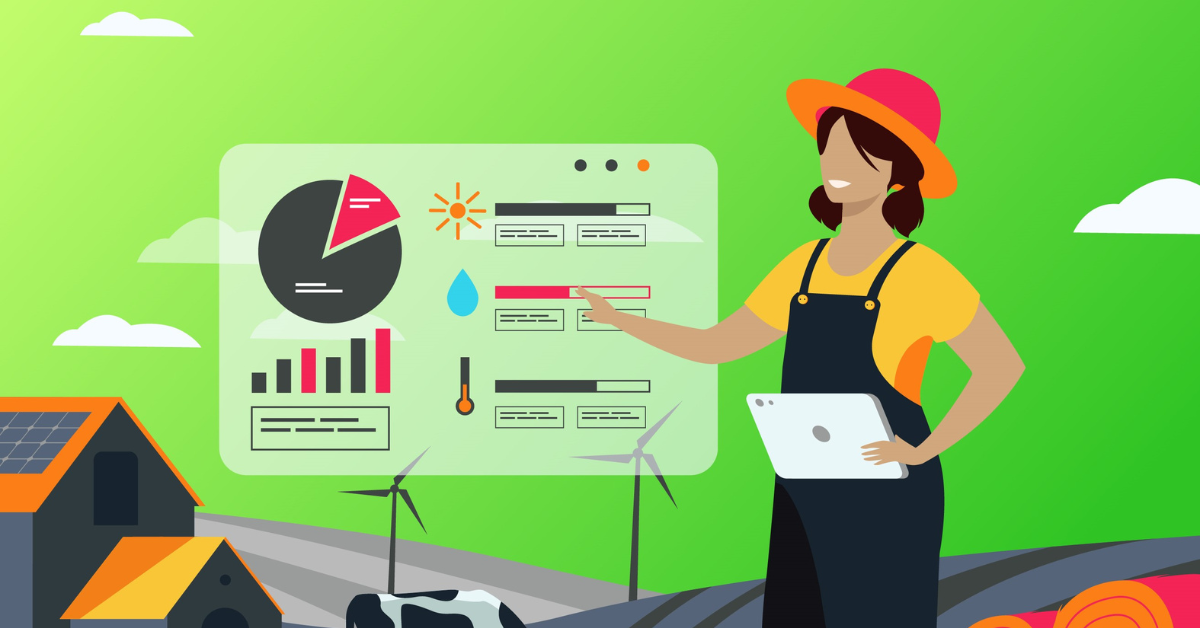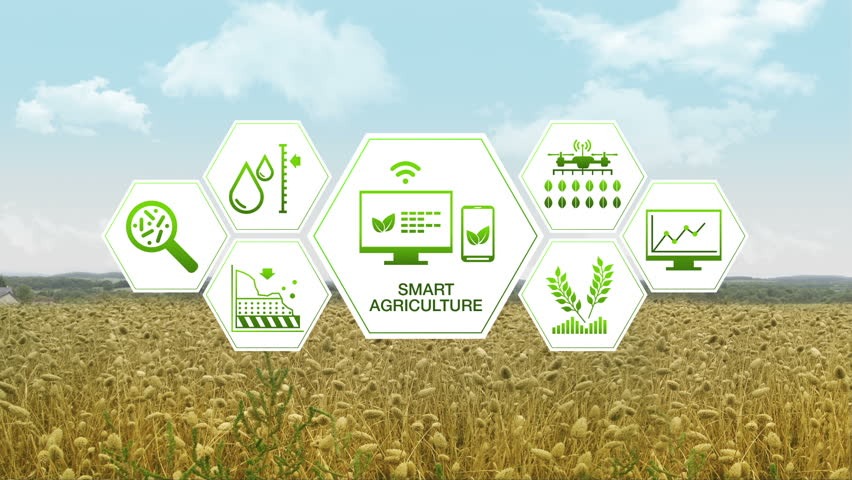Contact: +91 99725 24322 |
Menu
Menu
Quick summary: Discover how data-driven agriculture revolutionizes sustainable farming by utilizing advanced technologies for better decision-making, resource optimization, and environmental stewardship.

Climate change, population growth, and resource depletion are threatening food security and the agricultural sector faces a pressing challenge: how to produce more with less. As farmers grapple with the impacts of unpredictable weather patterns and diminishing arable land, the need for innovative solutions has never been more critical. Data-driven agriculture is a powerful approach that leverages technology and analytics to optimize farming practices and enhance sustainability.
According to a report by the Food and Agriculture Organization (FAO), about one-third of food produced for human consumption is wasted, and data-driven strategies can play a pivotal role in minimizing this loss
However, many farmers still rely on traditional methods, often resulting in inefficient resource use and missed opportunities for improvement. This not only affects their bottom line but also contributes to environmental degradation.. By harnessing real-time data, farmers can make informed decisions that lead to better yield predictions, efficient water usage, and reduced pesticide application, ultimately paving the way for a more sustainable agricultural landscape.
Key Takeaways
Data-driven agriculture is transforming the landscape of farming, particularly in the context of sustainable practices. By utilizing advanced technologies and data analytics, farmers can make informed decisions that lead to increased efficiency, reduced waste, and improved environmental stewardship. Here’s how data-driven agriculture contributes to sustainable farming:
Data-driven agriculture enables precision farming, which involves using technology to monitor and manage field variability. This approach allows farmers to apply inputs like water, fertilizers, and pesticides more accurately, minimizing overuse and reducing environmental impact. For example, sensor technologies and satellite imagery can provide real-time data on soil moisture levels and crop health, allowing for targeted interventions that improve crop yields while conserving resources .
Farmers can leverage data analytics to optimize resource management. By analyzing historical data and current conditions, they can forecast water needs, plan irrigation schedules, and manage nutrient applications effectively. This not only enhances productivity but also helps conserve vital resources.
According to a study by McKinsey, adopting data-driven practices in agriculture can lead to a 20-30% increase in crop yields while reducing water use .
Making informed judgments on crop selection and planting is made easier with the use of historical data and predictive analytics. Predictive analytics is the process of predicting future events by examining past market trends, weather patterns, and crop performance. Farmers can then choose the best crops to grow and arrange their planting for maximum yields and market demand.
The monitoring of crop health and pest management in agriculture is made possible by data-driven techniques. Farmers can identify potential problems early on by gathering information on plant growth, insect prevalence, and disease symptoms. For increased yields and decreased losses, crop health is maintained, pest control tactics are optimized, and timely interventions are implemented thanks to data analysis.
The KMIT project leveraged the capabilities of the TraceX farm management platform to unite all participants in the maize supply chain on a shared collaborative platform. This strategy enhanced productivity and profitability for farmers while simultaneously reinforcing the sustainability of the entire supply chain.
Data-driven agriculture helps farmers adapt to climate change by providing insights into weather patterns and climate variability. This information can guide planting schedules, crop selection, and risk management strategies, enabling farmers to build resilience against extreme weather events. By utilizing predictive analytics, farmers can make proactive decisions that mitigate risks associated with climate-related challenges
Using data technology, farmers can enhance the traceability of their products from farm to table. Blockchain and IoT devices can track the journey of agricultural products, ensuring transparency in sourcing and production practices. This not only builds consumer trust but also supports sustainable sourcing practices by allowing consumers to make informed choices about the products they purchase.
Remote sensing is a pivotal component of data-driven agriculture, enabling farmers to gather and analyze critical information about their crops and fields without being physically present. This technology uses satellite imagery, drones, and other aerial platforms to monitor various agricultural parameters, leading to more informed decision-making and enhanced efficiency.
Farmers are better able to make educated pricing and market decisions when they have access to real-time market information. Farmers can improve profitability and market competitiveness by adjusting their pricing strategies, identifying market opportunities, and making educated decisions about product timing, quantities, and marketing channels by keeping up with market trends, demand-supply dynamics, and competitor pricing.
For farmers, value chain optimization and direct market access are made possible through integration into digital platforms. Farmers can communicate with buyers directly by utilizing e-commerce platforms, internet marketplaces, or mobile applications, cutting out middlemen. This makes it possible to manage the supply chain effectively, set fair prices, and increase market transparency, all of which boost smallholder farmers’ profitability and access to markets.
Procurement management software can enhance operational efficiency through features like automated record-keeping, real-time inventory management, and data analytics. These tools help farmers optimize resource allocation, minimize waste, and respond more swiftly to market demands, further solidifying their position in the competitive agricultural landscape.
For smallholder farmers data-driven agriculture is essential since it provides them with critical information to maximize their productivity and sustainability. Farmers may choose the best crops for irrigation, fertilization, pest management, and market trends by gathering and analyzing data on weather patterns, soil characteristics, crop health, and market trends. They can maximize yields, minimize resource waste, cut costs, and increase profitability as a result. Furthermore, data-driven agriculture encourages precision farming, effective resource management, and better risk management, ultimately enhancing the livelihoods and resilience of smallholder farmers.
Utilizing insights obtained from data analysis, data-driven initiatives increase production, efficiency, and profitability in agriculture. Smart Farming helps to improve their farming practices by tracking and evaluating elements including weather patterns, soil quality, and crop health. This involves targeted pest and disease management, precise crop selection, irrigation, and fertilization. Farmers may decrease resource waste, optimize resource allocation, boost yields, and enhance overall efficiency by making data-driven decisions. This improves production and profitability, which ultimately helps the agricultural industry and farmers’ livelihoods.
Agriculture that is “data-driven” makes use of technology, data analysis, and data collection to improve farming methods. It has the potential to boost agricultural production, profitability, and sustainability through advantages like enhanced crop yields, resource efficiency, risk management, and informed decision-making.
Weather data: For smallholder farmers to make educated decisions about irrigation, planting dates, and crop management, they need information on temperature, rainfall, humidity, and other meteorological characteristics.
Soil data: Farmers are assisted in choosing the best fertilization, soil amendments, and soil conservation techniques for their crops by data on soil properties, such as nutrient levels, pH, organic matter content, and soil texture.
Market data: Smallholder farmers may choose crops wisely, decide when to harvest them, and develop effective marketing plans thanks to access to market information, such as prices, demand trends, and consumer preferences.
In today’s complicated and data-driven environment, data collection, management, and analysis are essential for efficient decision-making. They give decision-makers the knowledge and understanding they need to make wise decisions, allocate resources efficiently, and manage risks. Decision-makers can spot patterns, trends, and correlations that might otherwise go undetected by gathering pertinent data, organizing it through effective management systems, and analyzing it with cutting-edge methods. As a result, they are better able to comprehend the situation as it is, forecast future events, weigh their options, and decide on the best course of action. Making decisions based on data improves effectiveness, profitability, and outcomes across industries and sectors.

TraceX’s farm management platform drives data-driven agriculture by integrating advanced technology solutions that enhance transparency, traceability, and operational efficiency throughout the agricultural supply chain. By leveraging blockchain technology, the platform ensures accurate data collection and sharing among all stakeholders, from farmers to consumers. This facilitates real-time monitoring of farming practices, enabling farmers to make informed decisions based on data analytics. Features like automated record-keeping, yield tracking, and quality assessment empower farmers to optimize resource use and improve crop management. Additionally, the platform supports compliance with sustainability standards, helping farmers adopt practices that meet regulatory requirements while enhancing their market competitiveness.
In conclusion, data-driven agriculture stands as a transformative force for sustainable farming practices. By harnessing advanced technologies such as remote sensing, big data analytics, and IoT devices, farmers can make informed decisions that optimize resource use, enhance crop yields, and minimize environmental impact. This integration of data not only empowers farmers to respond dynamically to changing market demands but also fosters a more resilient agricultural system capable of addressing global challenges like climate change and food security. As the agricultural sector continues to evolve, embracing data-driven strategies will be vital for achieving long-term sustainability and profitability.
Data-driven agriculture refers to the use of technology and data analytics to enhance farming practices. It involves collecting and analyzing data from various sources, such as satellite imagery and sensors, to make informed decisions that improve crop yields and sustainability.
By leveraging data, farmers can optimize resource use (like water and fertilizers), reduce waste, and enhance crop management practices. This leads to improved environmental stewardship and lower carbon footprints, contributing to sustainable farming.
Key technologies include remote sensing, IoT devices, big data analytics, precision agriculture tools, and farm management software. These technologies work together to provide real-time insights and facilitate better decision-making for farmers.
